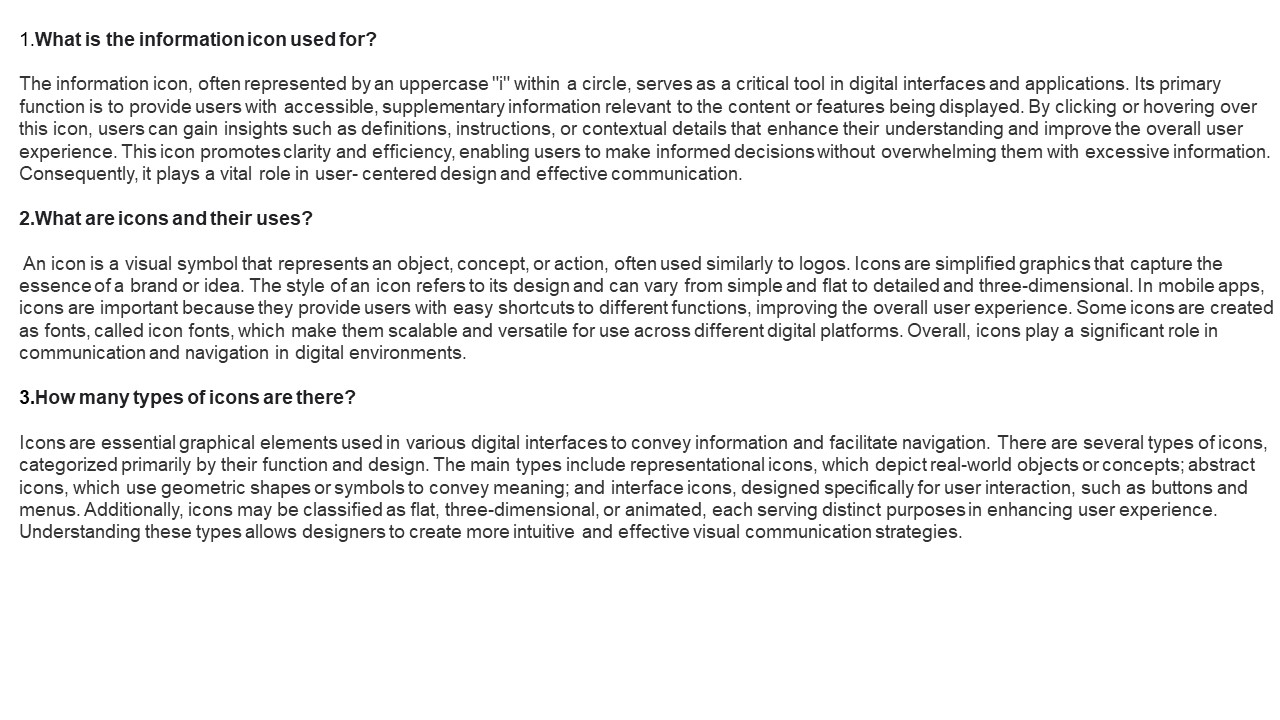A Comprehensive Guide to Icon Usage in Digital Interfaces - PowerPoint PPT Presentation
Title:
A Comprehensive Guide to Icon Usage in Digital Interfaces
Description:
A Comprehensive Guide to Icon Usage serves as an essential resource for designers, developers, and marketers aiming to enhance visual communication within their projects. This guide delves into the principles of icon design, including scalability, simplicity, and context, ensuring that icons serve their intended purpose effectively. It emphasizes the importance of consistency in style and color to maintain brand integrity across various platforms. – PowerPoint PPT presentation
Number of Views:0
Date added: 24 July 2024
Slides: 4
Provided by:
visualsculptors
Category:
How To, Education & Training
Tags:
Title: A Comprehensive Guide to Icon Usage in Digital Interfaces
1
1.What is the information icon used for? The
information icon, often represented by an
uppercase "i" within a circle, serves as a
critical tool in digital interfaces and
applications. Its primary function is to provide
users with accessible, supplementary information
relevant to the content or features being
displayed. By clicking or hovering over this
icon, users can gain insights such as
definitions, instructions, or contextual details
that enhance their understanding and improve the
overall user experience. This icon promotes
clarity and efficiency, enabling users to make
informed decisions without overwhelming them with
excessive information. Consequently, it plays a
vital role in user- centered design and effective
communication. 2.What are icons and their
uses? An icon is a visual symbol that
represents an object, concept, or action, often
used similarly to logos. Icons are simplified
graphics that capture the essence of a brand or
idea. The style of an icon refers to its design
and can vary from simple and flat to detailed and
three-dimensional. In mobile apps, icons are
important because they provide users with easy
shortcuts to different functions, improving the
overall user experience. Some icons are created
as fonts, called icon fonts, which make them
scalable and versatile for use across different
digital platforms. Overall, icons play a
significant role in communication and navigation
in digital environments. 3.How many types of
icons are there? Icons are essential graphical
elements used in various digital interfaces to
convey information and facilitate navigation.
There are several types of icons, categorized
primarily by their function and design. The main
types include representational icons, which
depict real-world objects or concepts abstract
icons, which use geometric shapes or symbols to
convey meaning and interface icons, designed
specifically for user interaction, such as
buttons and menus. Additionally, icons may be
classified as flat, three-dimensional, or
animated, each serving distinct purposes in
enhancing user experience. Understanding these
types allows designers to create more intuitive
and effective visual communication strategies.
2
4.What are the benefits of icons? Icons serve
as powerful visual tools in communication,
offering numerous benefits across various
contexts. They enhance user experience by
providing intuitive representations of actions
and information, thereby facilitating quicker
comprehension and navigation. Icons can
streamline interfaces, reducing cognitive load
and allowing users to focus on essential tasks.
Additionally, their ability to transcend language
barriers makes them invaluable in global
applications, promoting inclusivity and
accessibility. Furthermore, icons can evoke
emotional responses, reinforcing brand identity
and enhancing aesthetic appeal. By leveraging the
simplicity and clarity of icons, organizations
can improve efficiency, engagement, and overall
effectiveness in conveying messages and
functionalities. 5.What are the creative uses of
icons? Icons serve as powerful tools in visual
communication, transcending language barriers and
enhancing user experience across various
platforms. Creative uses of icons include
representing complex ideas succinctly, guiding
users through interfaces, and evoking emotions
aligned with brand identity. In marketing, they
can simplify product features or narrate a story,
making content more engaging. Additionally, icons
can be employed in educational materials to
facilitate learning and retention. By integrating
icons into design, professionals can foster
intuitive navigation, streamline information
presentation, and create memorable visual
narratives that resonate with diverse audiences,
ultimately enhancing both functionality and
aesthetic appeal. 6.What is the unique feature
of icons? Icons serve as powerful visual
representations that distil complex ideas into
universally recognizable symbols. Their unique
feature lies in their ability to convey meaning
at transcending language barriers and cultural
differences. This visual shorthand enhances
communication, making information more accessible
and engaging. Icons often evoke emotions and
associations, allowing for immediate recognition
and recall. Moreover, their simplicity and
clarity facilitate quick navigation in digital
interfaces, enhancing user experience. By
integrating aesthetic appeal with functional
purpose, icons not only enhance visual literacy
but also foster intuitive interactions, making
them indispensable tools in design and
communication strategies.
3
https//visualsculptors.com/ https//visualsculp
tors.com/our-portfolio/































